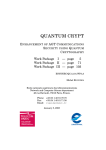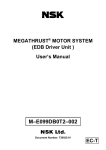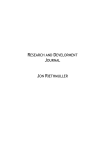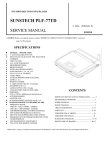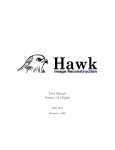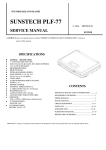Download Radio Hill Gazette, December 2014
Transcript
Volume XXXIX Issue XII December 2014 Table of Contents From the Editor.......................................................................................................................................2 A page from the contest diary..................................................................................................................3 A hike along the paper trail.....................................................................................................................4 SARC Leads Amateur Radio in Illinois..................................................................................................5 Grounding Ham Radio Equipment..........................................................................................................6 Useful HF Radio Features.....................................................................................................................10 Club roster information request.............................................................................................................12 Trading post, things for sale or trade.....................................................................................................13 Calendar and things to do......................................................................................................................14 December...........................................................................................................................................14 Looking ahead...................................................................................................................................14 VE Testing Results................................................................................................................................15 SARC Email Reflector..........................................................................................................................16 Club Nets...............................................................................................................................................16 Club Meetings.......................................................................................................................................16 Club Officers – 2014.............................................................................................................................16 Club Committees...................................................................................................................................16 Schaumburg Amateur Radio Club.........................................................................................................17 December 2014 Page |2 From the Editor Welcome to another edition of the Radio Hill Gazette. December represents the end of the calendar year, with holidays and social gatherings, not to mention the inclement weather that will likely pay us a visit. I hope you have cleaned up your outside antennas and such so you can have an uninterrupted winter operating season. There are plenty of chances to get on the air in December, so make use of those few cold days with some free time and get on the air. In case you didn't get the word, the worlds #1 most needed DX location was given approval and Navassa Island will be on the air in January 2015. I know, it's only December, but here is a chance for you to get ready to tick off the world's top needed station. You can see mission updates on their website, http://www.navassadx.com. Unlike other rare locations that are “far, far away”, this one is practically in out back yard. The island of Navassa is located in the Caribbean Sea, so well within reach of America's heartland. The pileups will likely be enormous, with basic LID and intentional QRM, but being so close, we should have openings just about 24 hours a day, so your chances to make contact are better than you might think. December also brings the second week for Illinois in the ARRL Centennial Celebration with W1AW/9 going on the air across the state beginning at 00z on December 3. We came up a few thousand contacts short of our goal in the first round and are looking to make up for lost ground as we shoot for the most productive state operation. I heard plans for an increased digital effort, so look for RTTY and PSK. Remember these operations primarily work split operation, so be ready for that. Look for us on all bands and modes, and work us as much as you can. Our entire team is eager for your contacts. Anthony Editor, RHG The Radio Hill Gazette, newsletter of the Schaumburg Amateur Radio club December 2014 Page |3 A page from the contest diary Anthony AB9YC This time around it's the ARRL November Sweepstakes CW contest. This was the first contest I ever did on my own, and my first ever CW contest (2012). Oh the memories, and they were documented in an article in the RHG, check it out, it's good reading. My goal for this event was to do better than I did last year where I logged 300 contacts and 76 multipliers (ARRL and RAC Sections, 83 in total). I'm still using my 100 watts and my tried and true fan dipole up 20 feet. Yes, you can work the country with just that. Sweepstakes is unique in that the exchange is long with 5 bits of information, and you cannot contact a station more than once regardless of band. With a little luck, you can work all states in just a weekend. Starting off, you have serial number 1, and if you can start at the beginning of the event, you can measure your pace against the serials you are logging. It won't take long to realize that some stations are just getting contacts in the log faster than you are. I started at the opening bell, basically running S&P. The band was loaded with signals so each contact was new, and most likely a multiplier and the score climbs quickly. I swept the high bands logging any contacts I could and there were always more to find. Not a few times, I would listen to an exchange and hear the station ahead of me giving a needed multiplier, I would mark this frequency and station, spin the dial up to find a free spot and start calling CQ. On several occasions, I managed to pull in that mult as he worked up the band; at least two, however, didn't pan out and I never got those in the log. During one such “hop”, I was chided because the station just below me thought I was impinging on his frequency and kept asking me to move. I couldn't hear him, and I eventually moved away. There's a lesson here, narrow filters on CW are your friend. I use a 300Hz filter which is quite narrow and can isolate +/- 200Hz with no problem. But someone running a wider filter, say 500Hz, is lucky to clear out +/- 300, and with crowded band conditions this makes for tough work. So, keep that in mind if you want to participate in CW contests. If you do this long enough, you begin to recognize calls, which makes contacts go quickly. Also, you will encounter on-air friends and can smile or toss in a few extra dit-dit's before moving on – one big happy family. I don't have any real experiences this time around that are worth mentioning. This was a typical contest where I ran when I could, scanned often looking for multipliers and had a good time operating for the amount of time I had available. In the end I logged 350 contacts and 78 multipliers, lacking only ORG, AK, PAC, NT & NL. Orange county, really? Of all the 6's none were from that needed multiplier, and this was one where I hopscotched to try and land without success; NT was another, but I failed there too. Had I missed only The Radio Hill Gazette, newsletter of the Schaumburg Amateur Radio club December 2014 Page |4 those two sections I would be pretty bummed, but since I was missing others too, it was clear I needed to work harder if I wanted a sweep. Running unassisted means I have to find my own multipliers and I really missed getting some tips for some needed mults. I managed PR, VI and several MAR so I was doing a good job getting them in the logs, but I just came up short. There's always next year. AB9YC A hike along the paper trail Anthony AB9YC Yep, nothing is over until the paperwork is complete. After each contest or operating session, I consolidate my logs and upload to Logbook of the World as well as a few DX log tracking sites. This gives me some additional tools for validating awards progress and helps to guide my on-air efforts. Hunting through my logs recently I came across a few DX entities that still had not confirmed, so I verified the contacts via email and got assurances that a QSL card would be returned. So, I sent off some cards, and now the waiting game begins. Also to be found from mining my log data was a couple new awards. I already have several WAS awards, in various modes and bands, but the logs support a WAS with QRP CW. So I documented that and now have that on the wall. Also, and here was a surprise, I achieved WAC with QRP CW. Again, assembled the supporting documentation and another piece of wall paper. Following my QRP WAC surprise I noticed that I'm one band short for a 5BWAC (all mode, all band, low power), lacking only AF, AS and SA on 80M; that's right, I've already completed WAC on 10M, 15M, 20M, and 40M. So, to help with that, I converted my ground mounted vertical for 40M to an inverted L for 80M. The first QSO on the antenna was to the DXPedition to Lord Howe Island on 30M. No, it wasn't 80M, but 30M is more fundamentally related to 80M that it worked where I really doubt it would have worked in the other configuration. I'll make a push during the CQ WW CW event at the end of November to see if I can round up some more continents on 80M. I'm excited to see how that works out, and am looking forward to staying up all night to find out. Just think, all this came about while looking through my logs. Keep logging those contacts and you can get there, too. See you on the bands. Anthony AB9YC dit dit The Radio Hill Gazette, newsletter of the Schaumburg Amateur Radio club December 2014 Page |5 SARC Leads Amateur Radio in Illinois Oct. 16, 2014: The Schaumburg Amateur Radio Club EM-Comm team was the only Amateur Club in the State of Illinois to participate in “The Great Shakeout”. This was a FEMA sponsored drill simulating an earthquake in order to test Emergency Management Operations and response throughout the State. SARC EM-Comm members were notified via the Schaumburg Everbridge system through the Northwest Community Communication Center. Members responded to the alert via text messages and checked into the “Net”. Later, SARC members reported to the pre-arranged deployment site with their equipment and were dispatched to locations around Schaumburg. During this exercise, simulated emergency traffic was passed to assist Village of Schaumburg emergency response assets. Although the exercise went well, areas needing improvement were noted. Currently, the Schaumburg Emergency Operations Center is not equipped with an amateur radio antenna. This required a SARC member, inside the EOC, to utilize a HT to access a SARC mobile rig with cross-band repeat capabilities. This setup worked, but was not an optimal situation. I believe that Village Officials, now, recognize the benefit of a permanent antenna installation at the EOC. Em-Comm team members also discovered some areas in need of improvement, such as: familiarity with standardized reports and forms, incomplete go-kits, and standard traffic handling techniques. Team members began to address these issues at the debriefing after the exercise. SARC EM-Comm members are vetted and credentialed by the Village of Schaumburg and are nonpaid volunteers for the Village. SARC members interested in joining can contact Bob Langsfeld, WB9TZC, or any current EM-Comm team member for more information. We can always use more members. The following article was written by the Village of Schaumburg and published in the weekly Schaumburg News Letter. “At 10:16 a.m. on Oct. 16, the Schaumburg Amateur Radio Club (SARC) Emergency Communications Team participated in ‘The Great ShakeOut’ Earthquake Drill to test the Team’s operational readiness. The SARC EM-Comm Team provides emergency radio communications in times of emergency and other public service activities as requested for the Village of Schaumburg. The SARC EM-Comm Team will be notified through the Village’s emergency notification system to determine member availability and report to a predetermined staging area for deployment to the Village’s critical facilities. Once on site the Team members will establish a communications link between the village facilities and provide emergency radio communications as needed. The SARC EM-Team is comprised of licensed Amateur Radio Operators who volunteer their time and equipment. As such, they are a valued resource to the Village for their operational readiness and skills they provide to the community in time of need.” The Radio Hill Gazette, newsletter of the Schaumburg Amateur Radio club December 2014 Page |6 Grounding Ham Radio Equipment Cliff Sowka K9QD Following is a recent email exchange that highlights some of the typical grounding questions that arise when building a Ham Radio shack installation. Simple Q & A exchange is then further discussed in detail. Q: What items in the Ham Shack require grounding? A: Everything should be bonded to a common ground point. Q: Should I ground my 12V power supply, the AC input or the DC output, or both? A: Ground the equipment cases but not the internal supply wires. Detailed discussion about electric service grounding as well as ancillary Radio Frequency (RF) grounding approach: Electric Utility Service Entrance looks like this. There is a grounding lug inside the Meter Case and a driven ground rod (found inside or nearby on the outside of the meter case) that bonds the electric service neutral leg and the metallic conduit piping system to earth. The Neutral Leg and Equipment Grounding schematic of the service entrance wiring will follow this basic approach: Notice there are two panels shown here; the main panel has the Neutral bonding lug connected to the Equipment grounding lug with what’s known as a jumper while ….. (IMPORTANT!) the sub-panel downstream has that jumper removed. There is a good reason for this jumper to be depopulated in downstream sub-panels but that discussion would require and entirely different and detailed treatise and won’t be covered in this study….suffice it to say if this connection between the Neutral and Equipment bonding lugs is missing in your installation, then your service is derived from a downstream sub-panel. The missing jumper could be as simple as a missing GREEN screw that isn’t driven into the metallic case. If that green screw is not there, then the Equipment bus is effectively and properly isolated from the metallic case. From an RF grounding perspective, that isn’t the end of the world but this does mean your effective earth grounding is somewhat lesser than it could be if your equipment panel had both buses tied together. The Equipment grounding lugs are still a good place to find The Radio Hill Gazette, newsletter of the Schaumburg Amateur Radio club December 2014 earth ground Page |7 for RF purposes. Q: I just put up three antennas (HF dipole, VHF J pole and a received only scanner antenna). I've got lmr 400 coax running to the HF and VHF antennas and rg6 to the other. I have a copper ground rod right next to the entrance to the basement of the house where the coax enters the house. A copper ground wire is wrapped around the shield of each line and runs to one of three acorn ground clamps on the ground rod, less than 2 feet from the house. I couldn't wrap the shield with 8 gauge because it wouldn't wrap well without potentially damaging the shield. I ended up using 12. A: 12 Ga is fine (bigger is always better but 12 Ga will get the energy started in the correct direction; the NEC Code wants 8 Ga) and will do a decent job of keeping lightning fingers from flying around and moving into the house looking for gas/water pipes when the copper ground rod outside gets saturated/overwhelmed in trying to dissipate a big stroke’s current (could be thousands of Amps) Q: Do I now have to run some type of additional grounding line from the ground rod to the service panel (or cold water copper pipe as an alternative) A: Always a good idea to have that ground rod tied to the electrical service ground. That way the whole house and antenna lines are all at the same potential (or lack of potential if you’re a lightning bolt). When lightning comes down the line, it will want to find the easy path and if your ground rod is good enough to get the charge dissipation process started ….. but if the lightning stroke finds that the electrical service panel’s ground is The Radio Hill Gazette, newsletter of the Schaumburg Amateur Radio club December 2014 Page |8 better, then you’ll see a giant flash across the grass and over to the meter case as the lightning goes looking for some additional paths that are more helpful in finding earth. Q: Will the cold water pipe connection suffice? A: Iron or copper water pipe is okay because that is also tied to the electrical service ground (by law even in the seventies) so that is a good alternative if the meter case is too far away. Q: This is easily doable since there is a copper cold water pipe just inside the coax entrance less than 3 feet from where the ground rod is. I know from reading up on this that this cold water pipe thing only works if the cold water pipe is connected in some fashion to the service panel and not all are, mostly on newer homes. This house was built in the 70's. Also there is a ground wire clamped on the cold water line that previously was used to ground a now removed satellite dish. Therefore, I'm assuming a ground to the cold water pipe will work? A: Yep it will work fine. Copper Grounding Bus for your Bench Q: Will this ground also serve as a sufficient RF ground inside the shack? I read something that suggests it would since the coax shield is already grounded to the outside ground rod. If not sufficient for RF what else would need to be done? Again there is another cold water pipe option as the main water pipe enters the basement next to the shack. A: Excellent place to connect your equipment grounds as well. A grounding lug strip found inside the laundry room’s fuse/breaker panel is a decent equipment grounding point. The ground in there is a compromise from a radiated Radio Frequency perspective but it’s a good alternative to a newlydriven stake outside (and two floors down). Even that newlydriven ground wire can be bringing all sorts of noise/junk up to your shack from the resident below you but it’s better than the service panel’s ground (better from an RF perspective anyway). Easy answer: Run all equipment grounds to a single, heavy copper strip mounted on your bench. Then have that copper strip terminated (maybe a single 8 gauge copper wire) to the service entrance panel’s equipment ground lug. The Neutral and Equipment ground lugs will be tied together inside the service entrance panel if this is the only panel supplying the loads. Detailed answer: If your service entrance panel is providing a termination for this 8 gauge wire, then life is easy. Tie the copper strip’s 8 gauge pigtail to the ground/equipment lug inside the breaker panel. If your service entrance panel isn’t nearby, then a somewhat poor compromise would be to use the equipment ground line that could be inside your outlet box. I say could because the requirement for this equipment ground wasn’t required in past NEC code if the building was installed with EMT (Electrical Metallic Tubing, known as conduit). EMT has usually provided a decent return path to the panel and could be relied upon to provide a low impedance path back to the breaker to enable its ability to clear a fault. Well, over the years, some EMT installations are not really providing a decent ground path anymore (corrosion, loose couplings, conduit breaks along the path) so the NEC now wants an equipment ground included along with the Line and Neutral. If you find three wires inside a typical duplex outlet box, then you’re like to have a pretty decent earth ground available without too much fuss. The Radio Hill Gazette, newsletter of the Schaumburg Amateur Radio club December 2014 Page |9 If you only have a Neutral and Line (one white wire paired with a color such as black) in the box, then the conduit system may suffice, but only an approximation for the real earth ground. If your wire infrastructure is Romex (known as rope in the trades), they it’s likely there will be an un-insulated copper wire in the box for equipment grounding. That will also suffice … but only an approximation for the real earth ground. In these two cases, the better way would be to run the 8 gauge wire to an outdoor 10’ - deep ground stake. That ground stake should also be bonded to the service entrance ground (found inside the meter case). If that isn’t practical, then just run the equipment ground line and you’ll have better ground than using the two alternatives (conduit or equipment ground) discussed earlier. Don’t ground the wires themselves of AC inputs nor the DC outputs of power supplies. Only ground the equipment cabinets of your power supplies and radio gear. All these ground wires terminate onto that nice, heavy copper strip on the bench. Green screw driven into the metallic panel confirms these Equipment Grounding lugs are tied to the Neutral. This means this is not a sub-panel. Therefore this grounding source could be a decent RF ground for the case where a separate, driven ground rod outside the shack isn’t practical. The Radio Hill Gazette, newsletter of the Schaumburg Amateur Radio club December 2014 P a g e | 10 Useful HF Radio Features Matt AC9IG Since I earned my license about 6 months ago I've spent a fair amount of time on the HF bands learning about on-air practices, propagation and my radio. This month I'm going to discuss a few features of the radio that I find particularly useful when making HF contacts. My radio is a Yaesu FT-450D, but from what I learned researching radios when I built my station, these features exist on most radio models. A quick trip to your radio's manual should help you locate a similar feature. The first feature that I tried out on the radio was the Digital Noise Reduction. It's no secret that there's a lot of random noise on the HF bands. This feature makes use of the DSP in the radio to help filter some of this noise. My first experience with it did not live up to the expectations that I had. It certainly did not take an SSB signal and make it sound as clear as an FM repeater. Although I may have set my expectations a little high. What I eventually found out was that noise reduction can make a substantial difference when the signal you're receiving is at least 4-5 S units above the noise floor. If the signal isn't that strong, then all it tends to do is make the audio sound muddier. I've used it to give my ears a bit of a break during rag chews where it does a nice job of suppressing some of the background noise. [Features like this work best with a good pair of HAM earphones, not so much with an external speaker. Ed.] By far, the two features of the radio that I use the most are the width and shift knobs. These two controls change the signal at the IF stage. The width control changes the pass band of the IF filter. This will affect the quality of the audio that you hear. My radio allows you to select between 1.8kHz, 2.4kHz, and 3.0kHz when operating SSB. When there are no stations on nearby frequencies, opening up the IF width to the full 3.0kHz will typically produce the easiest to listen to audio. However if the band is packed, especially on a contest weekend, closing down the bandwidth to 1.8kHz can eliminate noise from a station on a nearby frequency. This is illustrated in example B below. Note that the QRM at the higher frequency is no longer within the pass band (grey area) of the IF filter. This can greatly increase the intelligibility of the signal that you're interested in. Reproduced from the Yaesu FT-450D User Manual The Radio Hill Gazette, newsletter of the Schaumburg Amateur Radio club December 2014 P a g e | 11 The shift knob can be used in conjunction with the width knob to also help eliminate QRM from a nearby frequency. In example C above, the bandwidth has already been closed down to 1.8kHz, but now the IF frequency has been shifted slightly higher. Note how this now eliminates the QRM both below and above the desired signal. Again, this technique will reduce the quality of the audio that you are interested in, but the elimination of nearby noise will significantly outweigh the slight audio degradation. Try working with these two controls next time your QSO is squeezed in between two nearby stations. There a second way that you can use the shift control that is especially suited to a contest weekend. If you're waiting in a pileup and you're hearing noise from a nearby station you can quickly shift your IF frequency as far right and left as the control will allow. You'll immediately hear the nearby station get stronger when shifted one way vs. the other. This is exactly opposite of what I described in the paragraph above, but you're not going to leave the shift knob picking up all of that extra noise. Once you find the nearby station, get it out of your way by shifting in the opposite direction and make a mental note of where that station was. As soon as you break through this pileup you'll know exactly where the next station that you want to work is, either a few kHz above or below where you are now, based on what your quick twist of the shift knob revealed. The noise blanker is typically advertised as reducing ignition noise when you use your radio in a mobile situation. However, I've found a very specific use that has helped me out with a lot of contacts. My home has an electronic air cleaner as part of the furnace. When the blower in the furnace turns on, the air cleaner also charges up and usually arcs a few times because dust has settled on it. These arcs were causing very brief but strong wideband noise. I could hear it on all the HF bands when the air cleaner started up. The AGC in the radio would catch this and immediately reduce the gain which was nice, but the audio level was slow to recover. It typically meant I would lose 2-3 words in a QSO every time the unit arced. It was completely by chance that I had the noise blanker on when the furnace turned on, but I noticed immediately that the AGC was no longer tripping and dropping out my audio. Take a few moments to familiarize yourself with these features on your radio and give them a try. While you've got that manual out why not find out what some of those other buttons do. I know I'm finding out new things all the time about my radio. Matt AC9IG The Radio Hill Gazette, newsletter of the Schaumburg Amateur Radio club December 2014 P a g e | 12 Club roster information request Ladies and gentlemen, We are still trying to get information for the club roster. The information will be published only in paper form to prevent creation of spam emails etc, but will be useful to you and other members of the club, when you and they could use help in learning something. The spreadsheet requests the following information. If you don't want to provide all, you don't have to. (Actually, I was just looking at the list below, and I see it does not include offspring. It is possible that they could also benefit from knowing others from within SARC, as well.) The info you send will not be on Google groups if you send it only to him, and thus it won't be available to anyone else (except the NSA, and they already know all about you.) Name, Call Sign, License Class, First year licensed, SARC Committee Positions (current), SARC Committee Positions (former), Ham Radio Interests, Spouse Name, Home Address: City, State, Zip Code, Email Address, Home Phone, Cell Phone, Work Phone, Employer, Occupation, Former occupation, Other Interests or Hobbies, Special Abilities Please send your information to Jim at [email protected]. Let's make a Roster that can be really helpful. 73 de N9MVO, Rob The Radio Hill Gazette, newsletter of the Schaumburg Amateur Radio club December 2014 Trading post, things for sale or trade Drake transmitter model T-4XB, receiver model R-4B. Minimum bid $400. Hallicrafters model S-38B receiver. Minimum bid $20. Icom HT model 02AT. Minimum bid $20. The Radio Hill Gazette, newsletter of the Schaumburg Amateur Radio club P a g e | 13 December 2014 P a g e | 14 Calendar and things to do December ARRL Centennial QSO Party Board of directors meeting W1AW/9 IL Breakfast at Maxfields Club meeting EmComm Roundtable 1/1 – 365 days, all 50 states, all bands, many modes 3 3-9 6 18 20 There are plenty of contests this month operating in many modes on various bands, so find one and listen in. Check out http://www.hornucopia.com/contestcal/weeklycont.php to see what's coming up. Looking ahead Christmas Party Cruise January 15, 2015 2016 The Radio Hill Gazette, newsletter of the Schaumburg Amateur Radio club December 2014 P a g e | 15 VE Testing Results Results for November 1, 2014 Next Test December 6, 2014 Park District CRC; Sr. Center; Sunshine Room. NUMBER TESTED CLASS Technician General Extra Total 7 4 0 11 NEW LICENSE or UPGRADE 7 2 0 9 New/Upgraded Licenses: ****General**** ****Technician**** Michael Jones KD9CNV Jay Williams KD9CLS Braxton Miller KD9AAU Angelo Ralle KD9CLT James LeBurkien KD9CLU Antonio Pinto KD9CLV ****Amateur Extra**** Paul Mackwick KD9CNS Mark Gernardt KD9CNT Olivia Jones KD9CNU The SARC-sponsored VE exam sessions are held at 9:00 a.m. on the first Saturday of each month (unless it is a holiday or advised to the contrary by Schaumburg Park District) at Schaumburg Community Rec Center (CRC) 505 N. Springinsguth Road Schaumburg, IL 60168-0251 The CRC is located at the S.E. corner of Springinsguth and Bode Road, park in the North lot and enter through the North doors. Testing will be in the Sr. Sunshine Room, signs will be posted to guide the way to the room. The fee for taking a VE exam is $14.00. According to the FCC, the test fee allows an examinee one attempt to pass or fail each of the three examination elements. In addition, the order in which the examination elements are taken is not restricted; they may be taken out of sequence. As in the past, an identical fee will be assessed to any applicant who fails an exam and wants to retest at the same session. The only condition is that the same exam (identical set of questions) cannot be given to the Applicant, since all our exams are unique, this is not a problem at our sessions. Tom Doyle K9MF W5YI-VEC CVE & Test Session Manager 847-895-0174 Email: [email protected] The Radio Hill Gazette, newsletter of the Schaumburg Amateur Radio club December 2014 P a g e | 16 SARC Email Reflector Want to know what’s happening in the club? Join the club’s email reflector on Google groups. Point your web browser to: http://groups.google.com/group/sarc-all Click on the Join this group link. You can use your current email account to sign up or create a free Gmail account. You can elect to receive individual messages, a daily digest, or just read the messages on the Google Groups webpage. Club Nets Technical information net - Every Tuesday night at 7:30 pm. on the SARC Repeater 145.23 MHz.600 kHz WITH 107.2 Hz PL. Bring your Q&A’s Thursday nights are the 2 meter general information net on the SARC Repeater 145.23 MHz.-600 kHz with 107.2 Hz PL. at 8:00 PM (except meeting nights.) Club Meetings Club meetings are held at the Schaumburg Recreation Center (CRC) on the southeast corner of Springinsguth and Bode roads. Our nets are held every Thursday (except Meeting nights) at 8pm on the K9IIK repeater; 145.23 MHz -600 kHz with 107.2 Hz PL. Club Officers – 2014 President: Vice Pres. Secretary: Rob Glowacki N9MVO n9mvo <at> sbcglobal.net 847-981-1481 Leo Ribordy N9NBH leoribordy <at> sbcglobal.net 847-697-7616 Ray Parsons W9RAP Treasurer: Director: Director: Director: Director: Director: Albert Valdes Steve Karson Anthony Willard Cliff Sowka Ray Parsons Gary Bernstein K6K0K AC9EM AB9YC K9QD W9RAP N9VU (2016) (2016) (2014) (2014) (2015) Club Committees Programs Open RHG Anthony Willard, AB9YC Social ActivitiesRoger Ryan, W9RDR Publicity Open Membership Leo Ribordy, N9NBH Net Jim Brink, W9JFB Education Open Technical Assistance Ted Lester AB9SZ Public Service Rob Glowacki, N9MVO Fund Raising - Open Emergency Communications Bob Fox Hunt Coordinator Steve Karson, Langsfeld, WB9TZC AC9EM Special Events / Field Day Dennis White, Repeater Rob Glowacki, N9MVO KC9NZP The Radio Hill Gazette, newsletter of the Schaumburg Amateur Radio club December 2014 Schaumburg Amateur Radio Club Thursday Night 8:00 Net S.A.R.C. Repeater 145.230 MHz- 600 kHz PL=107.2 442.275 MHz +5 MHz PL=114.8 Hz Don't forget to check into the net! It will only take a minute and will let other club members know how you sound on the club repeater. The net features current club news, weekly NEWSLINE, news from other clubs and (of course) the swap-and-shop. Encourage your friends who are not yet members to check in with as well. Keep in mind that this is an open net and we encourage everyone to check in. See you Thursday at 8p.m. The Schaumburg Amateur Radio Club, Inc. is organized as a general not-for-profit corporation in the State of Illinois to render public service whenever applicable to the needs of the P a g e | 17 community and further various pursuits of amateur radio as a hobby. Meetings are generally held on the third Thursday of each month. Visitors are always welcome. Please send all submissions for the Radio Hill Gazette to the following address: Schaumburg Amateur Radio Club, Inc. 790 Washington Blvd. Hoffman Estates, IL 60169-3077 Or you can send by email to [email protected]. We solicit letters, articles, news items, quizzes, advertisements, suggestions, and criticism – plus anything else you can think of, including ideas to improve the RHG! Please make submissions by the 20th of the month for inclusion in the next issue. The editor reserves the right to edit submissions due to size or formatting limitations. S.A.R.C. shares newsletters with a number of other clubs. We scrutinize their publications very closely to make sure that we do not infringe on any copyrights. As a matter of form, we try to acknowledge all prior sources. Unless otherwise clearly identified as copyright protected, all material in the RHG may be used when due credit is given to the author and to SARC. SARC is a recognized ARRL Special Services Organization. The Schaumburg Amateur Radio Club publishes the Radio Hill Gazette monthly. Opinions expressed herein are those of the contributors and not necessarily those of the Schaumburg Amateur Radio Club. All contents of the Radio Hill Gazette, except where noted, are ©2014 of the Schaumburg Amateur Radio Club Inc. Articles and other material may only be copied when proper credit is given to both the author and to SARC. Visit the SARC Home Page at http://n9rjv.org The Radio Hill Gazette, newsletter of the Schaumburg Amateur Radio club



















